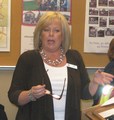Pilot program for “Learning Lunch Seminar Series” launched in the Cowichan Valley: Seminar #1 held on June 6, 2008
 “A message that we are hearing from local government is the increased expectation for rainwater management. For that reason, we have brought together this inter-governmental group to develop a policy framework for our region. We are hoping to foster a dialogue that will result in adoption of a set of tools for implementing green infrastructure that is based on a rainwater management way-of-thinking,” stated Kate Miller.
“A message that we are hearing from local government is the increased expectation for rainwater management. For that reason, we have brought together this inter-governmental group to develop a policy framework for our region. We are hoping to foster a dialogue that will result in adoption of a set of tools for implementing green infrastructure that is based on a rainwater management way-of-thinking,” stated Kate Miller.
Cowichan Valley Learning Lunch Seminar #2 – focus on legal and policy strategies
 ”
”
The Develop with Care guidance document is intended to assist people who are involved in planning, implementing, reviewing and/or approving land developments in British Columbia’s urban and rural areas. ts primary purpose is to provide province-wide guidelines for the maintenance of environmental values during the development of urban and rural lands,” stated Marlene Caskey.
Cowichan Valley Learning Lunch Seminar #3 – focus on watershed targets for protecting stream health
 “Within the Cowichan Valley Regional District, there are five local government jurisdictions; and the same group of developers and development consultants have projects in all or most of those jurisdictions. It therefore becomes essential that developers and their consultants hear a consistent message regarding rainwater management and green infrastructure expectations when doing business at the front counters in each of those jurisdictions,” stated Peter Nilsen.
“Within the Cowichan Valley Regional District, there are five local government jurisdictions; and the same group of developers and development consultants have projects in all or most of those jurisdictions. It therefore becomes essential that developers and their consultants hear a consistent message regarding rainwater management and green infrastructure expectations when doing business at the front counters in each of those jurisdictions,” stated Peter Nilsen.
Summary Report on Showcasing Green Infrastructure Innovation at the University of Victoria
 “This transformational experience resulted in a new vision for constructing water and energy efficient buildings in a built environment that respects the natural environment. UVic is leading by example in implementing approaches and practices that achieve Design with Nature outcomes, and reduce physical impacts resulting from intensive urbanization,” stated Sarah Webb.
“This transformational experience resulted in a new vision for constructing water and energy efficient buildings in a built environment that respects the natural environment. UVic is leading by example in implementing approaches and practices that achieve Design with Nature outcomes, and reduce physical impacts resulting from intensive urbanization,” stated Sarah Webb.
Showcasing Green Infrastructure Innovation at the University of Victoria: List of Water Bucket Stories
 Situated at the headwaters of Bowker Creek, the University of Victoria, a community of more than 25,000 people, is a case study for green buildings and compact growth. “In the third of three events that comprised the 2008 Showcasing Green Infrastructure Innovation on Vancouver Island Series, the University of Victoria and POLIS Project showcased how each is ‘walking the talk’ in turning theory into action,” stated Jody Watson.
Situated at the headwaters of Bowker Creek, the University of Victoria, a community of more than 25,000 people, is a case study for green buildings and compact growth. “In the third of three events that comprised the 2008 Showcasing Green Infrastructure Innovation on Vancouver Island Series, the University of Victoria and POLIS Project showcased how each is ‘walking the talk’ in turning theory into action,” stated Jody Watson.
Convening for Action at the University of Victoria: Towards a New Infrastructure – Integrated and Water-Centric Planning
 “The usual approach is to acquire land, decide what will be placed on it, then go about making it sustainable as possible. The layered approach effectively turns this upside down. Rather than being ‘fitted into the project’ after key decisions have been made, elements such as sustainability, amenity and social equity become the drivers of development outcomes,” explained Vic Derman.
“The usual approach is to acquire land, decide what will be placed on it, then go about making it sustainable as possible. The layered approach effectively turns this upside down. Rather than being ‘fitted into the project’ after key decisions have been made, elements such as sustainability, amenity and social equity become the drivers of development outcomes,” explained Vic Derman.
Showcasing Green Infrastructure Innovation: Towards a New Infrastructure – Integrated and Water-Centric Planning at the University of Victoria and Beyond
 “Emphasis will be on how water sustainability can be achieved through the ‘soft path’ for water and complemented by green infrastructure practices that flow from a Design with Nature guiding philosophy; especially when those infrastructure practices reflect a full and proper understanding of the relationship between land and water," reported Oliver Brandes.
“Emphasis will be on how water sustainability can be achieved through the ‘soft path’ for water and complemented by green infrastructure practices that flow from a Design with Nature guiding philosophy; especially when those infrastructure practices reflect a full and proper understanding of the relationship between land and water," reported Oliver Brandes.
Summary Report on Showcasing Green Infrastructure Innovation in the City of Langford
 Westhills is British Columbia’s largest LEED-Neighbourhood Development pilot project. “Westhills has design elements and community initiatives that create and nuture a strong sense of community; and a plan that incorporates leading-edge environmental technologies,” stated Darlene Tait. “The project integrates the principles of smart growth, new urbanism and green buildings into a system for neighbourhood design.”
Westhills is British Columbia’s largest LEED-Neighbourhood Development pilot project. “Westhills has design elements and community initiatives that create and nuture a strong sense of community; and a plan that incorporates leading-edge environmental technologies,” stated Darlene Tait. “The project integrates the principles of smart growth, new urbanism and green buildings into a system for neighbourhood design.”
Showcasing Green Infrastructure Innovation in the City of Langford: List of Water Bucket Stories
 Living Water Smart is the provincial government’s vision and plan to keep British Columbia’s water healthy and secure for the future. “The Showcasing Innovation Series adds depth to Living Water Smart by providing on-the-ground examples of the Province’s expectations look like in practice,” observed Lynn Kriwoken.
Living Water Smart is the provincial government’s vision and plan to keep British Columbia’s water healthy and secure for the future. “The Showcasing Innovation Series adds depth to Living Water Smart by providing on-the-ground examples of the Province’s expectations look like in practice,” observed Lynn Kriwoken.
Convening for Action in the City of Langford: Integrated Service Delivery – Transforming the Community
 At the heart of the City’s approach to innovation is its corporate philosophy for managing risk, learning by doing, and adapting quickly to new information and changing circumstances. “A corporate culture that is willing to accept and then manage risk with regards to infrastructure standards can open the door to creativity, innovation – and its rewards,” stated John Manson.
At the heart of the City’s approach to innovation is its corporate philosophy for managing risk, learning by doing, and adapting quickly to new information and changing circumstances. “A corporate culture that is willing to accept and then manage risk with regards to infrastructure standards can open the door to creativity, innovation – and its rewards,” stated John Manson.

